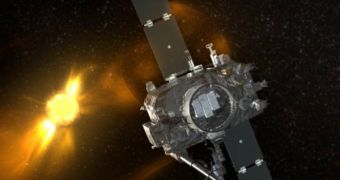The STEREO (Solar TErrestrial RElations Observatory) mission is the third one in the American space agency's Solar Terrestrial Probes program (STP), meant to provide experts with a better view of the interactions that occur between Earth and the Sun. Currently, the two identical crafts that make up the mission are taking 3D images of the planetary system, from various vantage points. One of them is moving “ahead” of our planet, on the same orbit, while the other “trails” behind, in very much the same way the Kepler Telescope does.
This allows them to analyze matter and radiation before they hit Earth, as well as afterwards. By differentiating between the two sets of readings, scientists hope to get a glimpse of the matter and energy transfers that take place between the two celestial bodies. The spots toward which the crafts are currently heading are the L4 and L5 Lagrangian points, places around the Earth where the gravitational pull of our planet is roughly the same as that of the Sun. This makes all five of these points resemble cosmic “parking spots,” which may house objects that have not fallen towards our planet or the star.
Researchers envision that one or more of these points could hold remnants of the solar system's ancient history, such as pieces of meteorites that got caught there, or even hints on how the Moon was formed, if, indeed, an impact created it. “These places may hold small asteroids, which could be leftovers from a Mars-sized planet that formed billions of years ago,” NASA Goddard Space Flight Center STEREO project scientist Michael Kaiser explains on the agency's website.
“According to Edward Belbruno and Richard Gott at Princeton University, about 4.5 billion years ago when the planets were still growing, this hypothetical world, called Theia, may have been nudged out of L4 or L5 by the increasing gravity of the other developing planets like Venus and sent on a collision course with Earth. The resulting impact blasted the outer layers of Theia and Earth into orbit, which eventually coalesced under their own gravity to form the moon,” he continues.
“If we discover the asteroids have the same composition as the Earth and moon, it will support Belbruno and Gott's version of the giant impact theory. The asteroids themselves could well be left-over from the formation of the solar system. Also, the L4/L5 regions might be the home of future Earth-impacting asteroids,” the official concludes.

 14 DAY TRIAL //
14 DAY TRIAL //